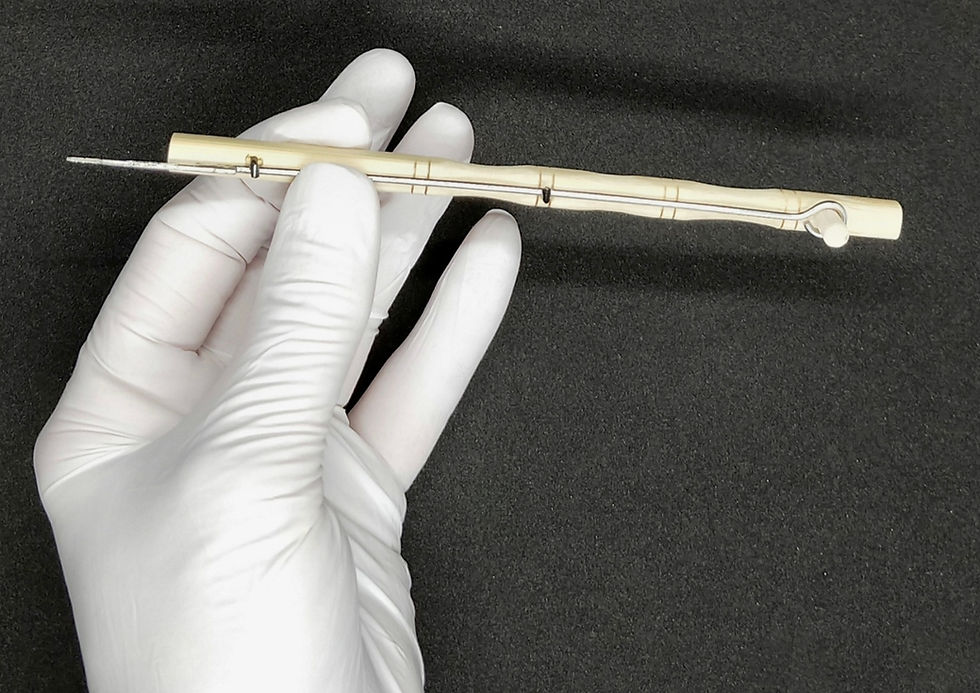Understanding Needle Sizes
- Lauren
- Mar 4, 2021
- 3 min read
Updated: May 24, 2023


When you are first getting into tattooing of any kind needle sizes, the codes, all the different names - it's confusing as heck. But fret not, we got you. Read on for some info on how to understand what those letters, numbers and names all mean.
Understanding Tattoo Needle Codes
Elements - Diameter:
The first number on a needle code always refers to the needle diameter. #12 needles are 0.35mm in diameter and regarded as standard. Bugpin needles are another fairly common size which are 0.25mm in diameter. You can get smaller or larger needle diameters however they are not anywhere near as commonly used.
Needle Count/Groupings:
The second number on the needle code refers to the number of needles in a grouping. Did you think every tattoo needle had one single point it that was just thinner or thicker depending on its size? (I sure did way back when). Nope! Each needle actually has a number of tiny needles (0.35mm thick needles to be exact - if we're talking standard #12 diameter needles) and this is what the second number in a needle code tells us. Confused? Understandable. Let's break it down. So, a #12/standard 1RL (code: 1201RL) has one point/grouping, meaning one tiny 0.35mm thick needle at its point, a #12/standard 3RL (code: 1203RL) has three points - three tiny 0.35mm thick needles at its point and so on....
Type Of Needle:
The third part of the code is the letters which refer to what type of needle it is and HOW the tiny points are grouped together. RL = Round Liner (grouped in a circle/round formation),
RS = Round Shader (grouped in a circle/round formation), F = Flat (grouped in a 'flat'/line formation), M2 = Stacked Magnum etc ect.
Some needle manufacturers/brands do it differently but the needles in our Poke Packs follow this code format: diameter - points - type of needle. Even more confused? Same at this point. Let's break THIS down a bit too. So for example, one of our most popular needles is a standard/#12 3RL (3 Round Liner) the code for this is 1203RL - 12 (diameter) - 03 (points) - RL (type of needle). As other examples the code for a standard/#12 5RS (5 Round Shader) is 1205RS - 12 (diameter) - 05 (points) - RS (type of needle), code for an extra tight 9 round liner is 1209RLXT - 12 (diameter) - 09 (points) - RLXT (round liner extra tight - type of needle) and code for a bugpin 4 round liner is 1004RL - 10 (diameter) - 04 (points) - RL (round liner - type of needle).
More On Types Of Tattoo Needles
Available in our Packs:
Standard Round Liners (RL) - Are (imo) the best type of needle for stick and poke/hand poke tattooing. As you probably ascertained from the name, they are grouped together in a circle creating a round marking and are designed to be used for creating lines.
Standard Round Shader (RS) - Are too fairly self explanatory. They create a round marking and are designed to be used for shading. In terms of shading they are a good option for poke tattooing.
Super/Extra Tight Round Liners (XTRL) - The same deal as round liners but the points are grouped tightly together creating a more precise, tighter round marking.
Bugpin Round Liners (RL) - Same deal as XTRLs but they also have a smaller diameter. So like the RLXT this means the needles on the point are grouped more tightly together but in the case of bugpins the diameter of the point is also smaller than a standard #12 needle creating an even more precise, even tighter round marking.
Not available in our Packs:
Other needle types we don't currently include in our Poke Packs are magnums and flats. Due to the size and style of a lot of stick and poke tattoos these are less commonly used and therefore we don't currently stock them in our Poke Packs. Magnum needles are used much more in machine tattooing as a tool for filling in large areas, colour packing and blending. Flat needles are used for thicker lines, some shading and colour fill.
Yeah Cool But What Kind Of Needle Should I Use?
It's hard to know exactly what kind of needle you should choose if you're new to all this so my advice is practice, play around and get to know the different options. A lot of it is just preference so you need to find what works and feels best for you :)
Below are some handy little images for some visual representation.
The difference in thickness of some of our stocked round liners:


Some examples of needle groupings:








Comments